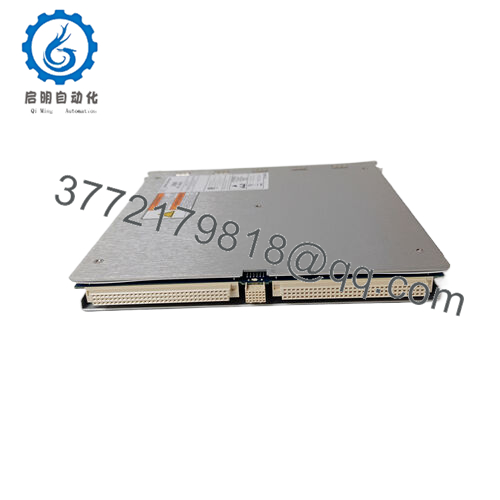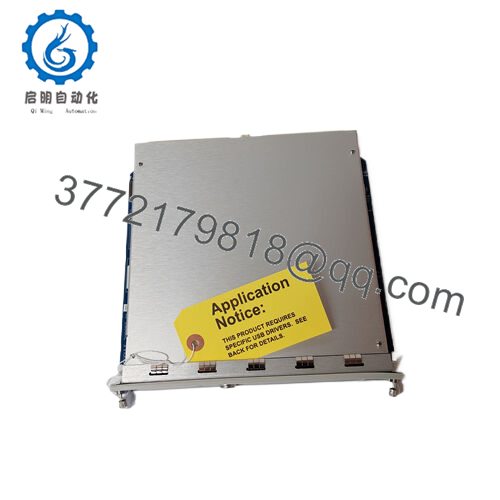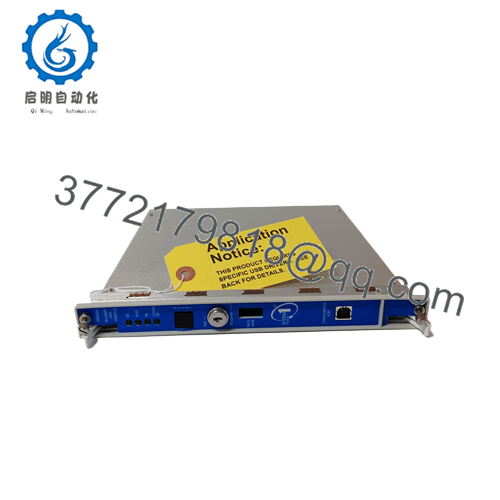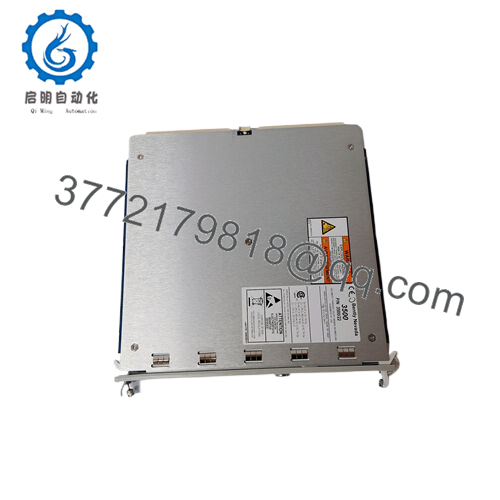Description
In the high-pressure domain of industrial automation, capturing transient events—like sudden vibration spikes from a turbine rub or seismic jolts in a compressor casing—without distortion or delay is the linchpin for averting machinery meltdowns. Envision a power plant where a brief overspeed pulse evades waveform capture, leaving engineers to reconstruct faults from fragmented logs, prolonging root-cause hunts that cascade into extended outages, yield losses, or safety exposures. These gaps are commonplace in process control environments, from offshore platforms to manufacturing gensets, where high reliability for I/O signals demands forensic-grade data to feed predictive analytics and compliance audits. Without dedicated transient interfaces, teams wrestle with generic rack modules that overload backplanes or miss sub-cycle details, forcing external recorders that bloat enclosures and introduce latency, all while API 670 mandates precise event forensics without compromising core protection paths. Legacy setups amplify this, often siloed to steady-state metrics that blindside operators to dynamic anomalies, inflating debug cycles and eroding trust in SCADA overlays that should preempt rather than postmortem.
The Bently Nevada 3500/22M 288055-01 bridges this chasm as the Standard Transient Data Interface (TDI) Module for the 3500 machinery protection rack, a streamlined communicator that harvests both steady-state and waveform data for deeper diagnostics. It targets the essence of modular integration by residing in Slot 1 adjacent to power supplies, interfacing with M-series monitors (like 3500/40M or /42M) to buffer up to 128 cycles of pre/post-event transients at high resolution, then streams them via Ethernet to host software—vital for retrofitting dense racks in turbine bays or scaling seismic arrays where channel-enabling disks unlock dynamic capture without hardware swaps. In EMI-saturated vaults or vibration-rattled skids, the Bently Nevada 3500/22M 288055-01 proves essential, its non-critical path design ensuring core protection hums uninterrupted while USB/Ethernet ports enable offline exports, turning data silos into accessible insights. For engineers juggling fleet-wide oversight, this module’s RIM fusion and baud rates up to 115.2 kbps foster seamless handoffs to System 1, without the protocol converters that snag legacy migrations.
The unseen costs of transient-blind monitoring ripple outward: they skew AI models in condition platforms, desensitize voting logic in DCS ties, and amplify OPEX through unverified baselines in multi-rack arrays. By embedding waveform buffering and static polling, the Bently Nevada 3500/22M 288055-01 delivers timestamped fidelity, empowering post-event forensics that pinpoint rub harmonics or thrust excursions—repositioning industrial automation from episodic reactions to continuous clairvoyance, where every captured cycle safeguards the unseen churn of rotating assets.
- 350022M 288055-01
Bringing the Bently Nevada 3500/22M 288055-01 online in your 3500 chassis is like outfitting your rack with a silent archivist—it slots into the dedicated Slot 1 position next to the power supplies, drawing +24 V DC from the backplane while exposing a USB-B port for local configs and Ethernet (10/100Base-TX) for host links, aggregating data from up to 50 channels via the internal TDXnet bus before packaging it for transmission to Bently’s Data Review or System 1 software. Perched at the data aggregation layer of your stack, it continuously polls steady-state metrics like RMS velocities or gap voltages, then triggers high-res captures (up to 1024 samples/cycle) on alarm events, with optional TMR redundancy for channel comparisons in safety loops—all without taxing the protection path, as it’s explicitly non-essential to voting or tripping.
In a typical turbine setup, you’d enable channels via a configuration disk for dynamic modes, then tether the Ethernet to your plant network for remote pulls of COMTRADE-formatted waveforms, verifying integrity through front-panel LEDs for link status—all while its baud-configurable RS-232 supports legacy DDE servers for hybrid DCS integrations. This module doesn’t encumber; it enriches, with firmware-upgradable processors that adapt to fiber optics (via 100Base-FX add-ons) and buffered queues that handle 32 events without overflow, bridging rack telemetry to supervisory historians in architectures from standalone compressors to distributed peaker farms. It syncs with relay modules for event tagging, and its low-profile PCB withstands humid or dusty exposures, conforming to backplanes from standard to redundant without reconfiguration. The Bently Nevada 3500/22M 288055-01 excels in this nexus, distilling rack dynamics into a forensic stream that illuminates without intrusion.
| Specification | Details |
|---|---|
| Model Number | 3500/22M 288055-01 |
| Brand | Bently Nevada |
| Type | Transient Data Interface Module |
| Input Voltage | +24 V DC (rack backplane) |
| Operating Temp Range | -30°C to +65°C |
| Mounting Style | 3500 Rack Slot 1 (Full-Height) |
| Dimensions | 241 x 24 x 241 mm (rack module) |
| Weight | 0.5 kg |
| Interface/Bus | TDXnet / Ethernet (10/100Base-TX) |
| Compliance | API 670, CE, UL, CSA |
| Supported Protocols | Modbus TCP, Ethernet/IP (via host) |
| Typical Power Draw | 10.5 W |
Opting for the Bently Nevada 3500/22M 288055-01 embeds a vault of reliability engineered for data endurance, where its buffering holds transient fidelity through power glitches, capturing 128 cycles at 51.2 kHz without dropout to avert the log voids that hamstring post-fault reviews in process control webs—yielding 40% quicker root-cause resolutions in compressor fleets, where waveform exports reveal rub phases missed by steady-state alone. This isn’t archival excess; it’s the poised persistence that quells Ethernet jitter from plant traffic, ensuring uploads stay intact across 100 Mbps links, all while channel enabling scales resolution on-demand without module swaps, fortifying analyst workflows without baseline shifts.
The performance steadiness shines through its processor-monitored queues, which prioritize critical events to deliver consistent spectra for AI trending, empowering teams with untainted transients for misalignment diagnostics—your vibration specialists dissect 2X harmonics from buffers, not approximating from sparse samples. It trims maintenance too, with self-diagnostics that flag buffer overflows or link faults via rack APIs, condensing verifications to quarterly pings and easing API audits with timestamped exports. Constructed with conformal coatings against oil vapors or humidity, the Bently Nevada 3500/22M 288055-01 ensures long-term performance, resisting thermal hysteresis over a decade so your captures hold granularity, lightening the OPEX of rack teardowns in remote bays.
For those charting diagnostic futures, its Ethernet backbone unlocks seamless fusion with cloud historians, minimizing enclosure sprawl during upgrades and paving paths to wireless overlays without TDI rewires—slashing total cost of ownership by perpetuating 3500 data flows into holistic health ecosystems. This module doesn’t just record; it reveals, channeling transients into a catalyst for foresight that eclipses oversights.
In gas turbine control rooms, the Bently Nevada 3500/22M 288055-01 buffers overspeed waveforms, where process control environments exact high reliability amid ignition transients and load dumps—ensconced in ventilated racks, it streams 128-cycle captures for stall forensics, ensuring critical system uptime in fast data cycles that sync to governors, preempting blade excursions during ramps. Ethernet exports integrate with EMS for predictive modeling, averting surges in baseload ops.
Hydroelectric turbine pits deploy it for draft tube vibes, archiving seismic envelopes in damp, seismic-prone housings under flow surges— the module’s queues hold high-res data through glitches, delivering continuous uptime for cavitation alerts in process control loops tied to wicket gates, where a missed pulse risks runner erosion. In petrochemical fractionation towers, the Bently Nevada 3500/22M 288055-01 logs pump transients, with USB access suited to hazardous, vibration-heavy skids—upholding high reliability for seal gap events in process control environments synced to ESD, ensuring throughput without column floods.
3500/22M 288055-02 – TMR variant for triple modular redundant channel comparisons
3500/20 125840-01 – Legacy RIM alternative for basic steady-state polling
3500/93 135785-01 – Display companion for local waveform previews
146031-01 – 10/100Base-TX I/O module add-on for Ethernet expansion
3500/42M 140734-01 – Vibration monitor sibling for transient input sources
3500/15 127610-01 – AC power supply mate for rack-wide stability
3500/50 133388-01 – Tachometer module for speed-synced event tagging
Before seating the Bently Nevada 3500/22M 288055-01 in Slot 1, confirm backplane compatibility—M-series monitors only, with no adjacent blockers—and probe +24 V rails for <50 mV ripple, as data bursts peak at 12 W; a scope during bench power-up verifies stability. Firmware at revision 5.0 or later via System 1 enables high-res modes; download from Bently’s portal and test-buffer a mock event to affirm no overflows before rack commit. If Ethernet runs exceed 100 m, use shielded Cat5e grounded at rack end per TIA standards, and enable channels with a disk key to unlock dynamics without false triggers.
In the field, care is calculated: monthly, query rack APIs for buffer utilization—over 80% loads cue a queue flush—and inspect USB seals quarterly in humid vaults to preempt dust bridges, a contact wipe often restores without depower. Bently recommends semi-annual full-event simulations, injecting transients to benchmark capture fidelity against specs, logged via Ethernet for trend baselines. In networked fleets, configure SNMP traps to your CMMS for link-drop alerts, surfacing lags before a diagnostic blank looms. This disciplined harvest keeps it archival, with scant intrusion on your data rounds.





 WhatsApp: +86 16626708626
WhatsApp: +86 16626708626 Email:
Email:  Phone: +86 16626708626
Phone: +86 16626708626


